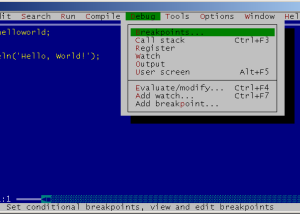
- #TURBO PASCAL FOR WINDOWS 10 HOW TO#
- #TURBO PASCAL FOR WINDOWS 10 MANUAL#
- #TURBO PASCAL FOR WINDOWS 10 SOFTWARE#
- #TURBO PASCAL FOR WINDOWS 10 PC#
Turbo Pascal 3.02 for the PC Another Pascal compiler: Hisoft Pascal 80 Pascal development environments Turbo Pascal out of the box is not able to use the MSX facilities. Turbo Pascal 3.01 for the PC Untouched (and now freeware!) Turbo Pascal DataBASE Toolkit 1.2, official add-on by BorlandFor MS-DOS with debugger (handy crosscompiling!) This is the official distribution placed here with permission of Frits Hilderink!
#TURBO PASCAL FOR WINDOWS 10 PC#
MSX-2 version of Turbo Pascal 3 Made by MCE aka Frits Hilderink including the GIOS and a PC version!
#TURBO PASCAL FOR WINDOWS 10 MANUAL#
The manual of Turbo Pascal 3.0 (MS-DOS, CP/M-86 and CP/M/MSX-DOS) is also available, thanks to Fred Kraan Click on each image to display a larger version of each cover. The floppy disk placed inside the manual cover along with the license agreement, invitation to join on CompuServe forums and other paper marketing pieces. Back in those days the manual was the product. Manual, Front and Back CoverBelow are scanned images of the front and back covers of the Turbo Pascal 3 manual.

#TURBO PASCAL FOR WINDOWS 10 HOW TO#
Read this great introduction how to write GOOD programs! Version 3 was the last version for CP/M, on the PC many versions followed (Borland Pascal 7 was the last DOS-based) and eventually evolved to Delphi (Windows) and Kylix (Linux). Alas it was not standard Pascal, instead very practical adapted to the CP/M and MS-DOS environment.
#TURBO PASCAL FOR WINDOWS 10 SOFTWARE#
The language itself is a standard now (ANSI) but also served as model used by Wirth for more advanced (modular) languages such as Modula and Oberon.īorland produced Turbo Pascal both for CP/M and MS-DOS, version 3 was a huge success and much of the software in the eighties on small computers is written with Turbo Pascal. It served as the main programming language to teach structured programming.Many compilers were available for all current platforms these days.


Pascal was used in the seventies and eighties as the computer language in programming education. According to the Pascal Standard (ISO 7185), these goals were to a) make available a language suitable for teaching programming as a systematic discipline based on fundamental concepts clearly and naturally reflected by the language, and b) to define a language whose implementations could be both reliable and efficient on then-available computers. There were two original goals for Pascal. He based it upon the block structured style of the Algol programming language. Niklaus Wirth completed development of the original Pascal programming language in 1970. In 1650, Pascal left the world of geometry and physics, and shifted his focus towards religious studies, or, as Pascal wrote, to “contemplate the greatness and the misery of man.” Pascal died in Paris on August 19, 1662. He would improve upon the instrument eight years later. In 1641, at the age of eighteen, Pascal constructed the first arithmetical machine, arguably the first computer. The Pascal language was named after Blaise Pascal (see picture), a French mathematician who was a pioneer in computer development history.


 0 kommentar(er)
0 kommentar(er)
